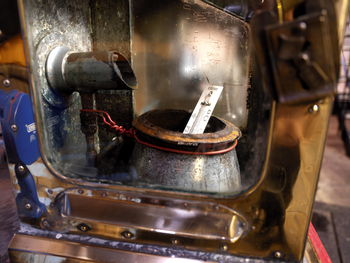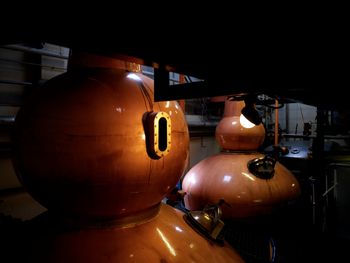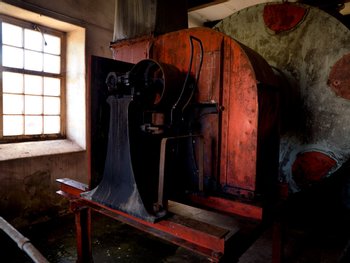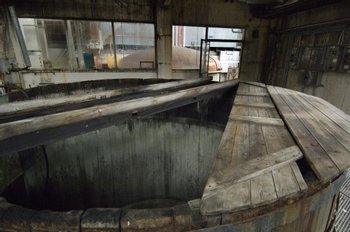
Bottled History
£30
This photographic coffee table book was produced in collaboration with Eddie Ephraums and Envisage publications. It distills the fruits of 5 years spent exploring the oldest of Scotland’s whisky distilleries seeking out obsolete equipment and endangered traditional processes. The author gained access to 55 distilleries all built before 1960 and ranging from Wigtown to Orkney. At the same time he sought out elderly former employees of the industry and assisted by a few drams encouraged them to tell him the stories of the times prior to multinational acquisition, when the exciseman was the enemy and the workforce enjoyed a camaraderie now only a distant memory. The rear of the book contains a brief account of the circumstances behind each picture and its location. This book has enjoyed steady sales for ten years and has been much enjoyed by all lovers of Scottish Malt Whisky. Slainte !
Now down to last 50 copies - price is increased to the original publication price of £30 Thiis is a high quality coffee table book and is still very good value.



Playing 'Beall'
Beall
Bill
Frank Massie
Gordon Grant
Neil Ferguson
Ruari Macleod
Bottled History by Ian Macilwain is definitely not just another book on Whisky. Superbly presented, this book will and should sit handsomely with any serious collection of Malt Whisky. None of the well thought out and composed photographs are from distilleries younger than 1960. They say a good photograph is worth a thousand words, each and every one certainly does this! A compelling book that is very hard to put down and even easier to pick up.
- Arkwrights
This is a quite lovely large format book of illustrations from areas of distilleries that the public rarely see. The pictures have an almost tactile feel to them, a sort of meditative grunge, and relate an era fast disappearing in the industry today. Old toolsheds, stillhouses that are no longer working, chipped paint, disused spirit safes, gloomy warehouses and so on. The author is also the photographer who took the pictures and he has a good eye. This is one for the whisky book collector and at the price, excellent value.
- LF
This is a quite lovely large format book of illustrations from areas of distilleries that the public rarely see. The pictures have an almost tactile feel to them, a sort of meditative grunge, and relate an era fast disappearing in the industry today. Old toolsheds, stillhouses that are no longer working, chipped paint, disused spirit safes, gloomy warehouses and so on. The author is also the photographer who took the pictures and he has a good eye. This is one for the whisky book collector and at the price, excellent value.
- LB
What a wonderful surprise I got this morning when I found your book on my desk,its absolutely beautiful in every way and something you can be very proud of as I am of my copy which you can sign when your over at the Festival, thank you so much its a treasure and I will share it with many people as I intend to buy a copy for the Academy students to enjoy, so there is your first sale and I hope you sell many many more, Slainte Jim.
- Jim McEwan
Still Life- Malt Advocate USA Bottled History by Ian MacIlwain Book review by Jonny McCormick, Bottled History; Feints, Fellows and Photographs by Ian MacIlwain Envisage Books I Ian MacIlwain’s first published collection of Scottish distillery photographs is a cherished treasure. Shunning the more polished distillery visitor attractions, he aligns his Hasselblad towards scenes of silenced machines, industrial neglect and beautiful decay. Belt-driven engine wheels at Glentauchers, the claws of a rake on the malting floor at Bruichladdich, Rosebank’s copper stills indignantly streaked in decades of pigeon excretions, first light reflecting off rainwater pooled in the ellipses of cask heads at Ardbeg and the Pulteney stills glowing like a deep-sea submarine on maneuver. MacIlwain’s preference is to work in natural light; his palette comprising ocherous tones and muted verdigris, creating a portfolio steeped in poignancy and nostalgia. Despite first appearances, this is not a book of ghosts. Operational shots such as Highland Park’s infernal kiln, the vibrant gush through the spirit safes of Jura and Glen Scotia, weak light outlining the hulks of sleeping casks of Bladnoch emphasize the fine line between production and dormancy that distilleries face through cycles of boom and bust. Taking its title from Ian’s metaphor of whisky as a time capsule transporting you to its era of production, this large format coffee table book seamlessly works through the stages of malt whisky production from malting to maturation in the dunnage warehouse, much of it photographed in Springbank and Bruichladdich distilleries. The physical labors of distillery work are starkly absent from the imagery, yet the accompanying testimony and reminiscences of former stillmen, mashmen, coppersmiths and distillery managers tangibly anchor the images in an era still in living memory. This oral history, often transcribed phonetically from the prevalent dialect of the North East of Scotland, encapsulates the men’s working lives from the demanding physical toil, the preservation of operational continuity reliant on ingenuity and cunning and the camaraderie of the workforce (there are gambling scams, the taking of the dram and the clandestine sustenance enjoyed by the nightshift surreptitiously drained from seemingly emptied casks). This is a fresh approach to whisky publishing, a body of work not reliant on the A-Z of distillery names for structure. Technical terms are explained and a slang dictionary will elucidate words like stotterin and quines for those “who’ve no got a gud Scottish tongue in their heids!” Bruichladdich’s Jim McEwan’s succinct introduction is testament to the book’s success, as the photographs clearly struck a chord in his heart and reflect, in his words, “the golden years of single malt production”. The footnotes and thumbnails at the end of the book preserve the clarity of the main section, but deserve equal attention for MacIlwain’s personal insights into the atmosphere and discoveries made at each location. Admittedly some of the book’s double spreads lack originality in their composition and fail to take advantage of the extra scale, but overall there is much pleasure to be had in the scrutiny of the minutiae from the fissured surface of cut peat, blistering paintwork, the ominous glare of a generator through its well greased façade to light shafts cast through a clouded window pane.
- Jonny McCormick

